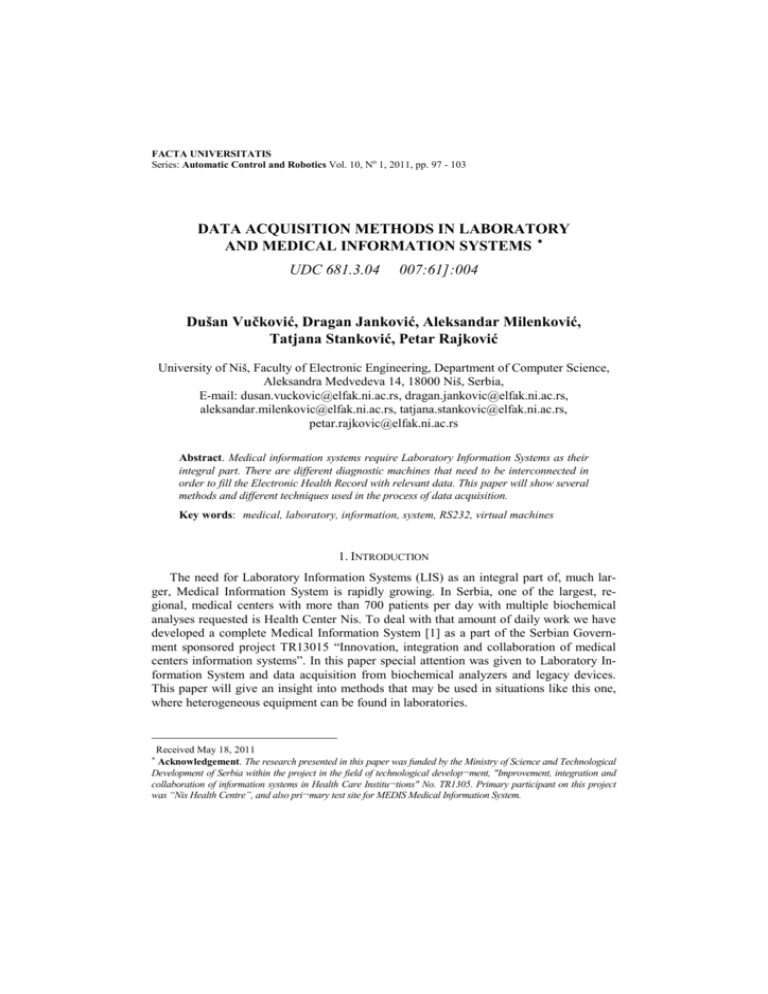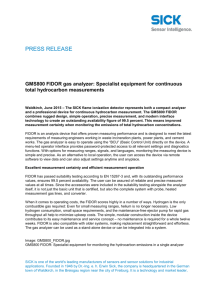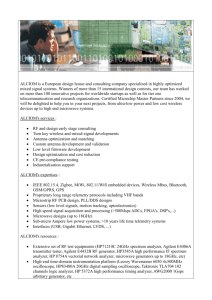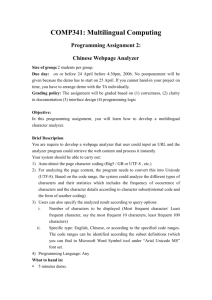DATA ACQUISITION METHODS IN
advertisement

FACTA UNIVERSITATIS Series: Automatic Control and Robotics Vol. 10, No 1, 2011, pp. 97 - 103 DATA ACQUISITION METHODS IN LABORATORY AND MEDICAL INFORMATION SYSTEMS UDC 681.3.04 007:61]:004 Dušan Vučković, Dragan Janković, Aleksandar Milenković, Tatjana Stanković, Petar Rajković University of Niš, Faculty of Electronic Engineering, Department of Computer Science, Aleksandra Medvedeva 14, 18000 Niš, Serbia, E-mail: dusan.vuckovic@elfak.ni.ac.rs, dragan.jankovic@elfak.ni.ac.rs, aleksandar.milenkovic@elfak.ni.ac.rs, tatjana.stankovic@elfak.ni.ac.rs, petar.rajkovic@elfak.ni.ac.rs Abstract. Medical information systems require Laboratory Information Systems as their integral part. There are different diagnostic machines that need to be interconnected in order to fill the Electronic Health Record with relevant data. This paper will show several methods and different techniques used in the process of data acquisition. Key words: medical, laboratory, information, system, RS232, virtual machines 1. INTRODUCTION The need for Laboratory Information Systems (LIS) as an integral part of, much larger, Medical Information System is rapidly growing. In Serbia, one of the largest, regional, medical centers with more than 700 patients per day with multiple biochemical analyses requested is Health Center Nis. To deal with that amount of daily work we have developed a complete Medical Information System [1] as a part of the Serbian Government sponsored project TR13015 “Innovation, integration and collaboration of medical centers information systems”. In this paper special attention was given to Laboratory Information System and data acquisition from biochemical analyzers and legacy devices. This paper will give an insight into methods that may be used in situations like this one, where heterogeneous equipment can be found in laboratories. Received May 18, 2011 Acknowledgement. The research presented in this paper was funded by the Ministry of Science and Technological Development of Serbia within the project in the field of technological develop¬ment, "Improvement, integration and collaboration of information systems in Health Care Institu¬tions" No. TR1305. Primary participant on this project was “Nis Health Centre”, and also pri¬mary test site for MEDIS Medical Information System. 98 D. VUČKOVIĆ, D. JANKOVIĆ, A. MILENKOVIĆ, T. STANKOVIĆ, P. RAJKOVIĆ 2. MATERIALS AND METHODS The first and foremost problem that anyone developing Laboratory Information System will encounter is the difference in communication protocols on equipment from different vendors. Most of the devices still have RS232 interface as primary means of communication with external station. Some vendors have specialized software that can be installed on the computer connected to RS232 port and use it to program the biochemical analyzer. This software is very expensive and often very hard to integrate into the existing information systems. Another question is whether or not to disturb the existing methodology and workflow of laboratory personnel by introducing new centralized device programming. This might look strange from a technical point of view, but many laboratories have more than a decade of experience and well-rehearsed procedures. New methodology might just slow them down. Before LIS integration into Medical Information System, excessive hardware and software analysis should be done. Different vendors imply different communication protocols, as well as various interconnection methods [2]. Data acquisition from biochemical analyzers requires drivers for every brand, or even a different driver for each model of the same brand. Different data acquisition techniques may be applied. One of them, which is currently under development, involves creation of an intermediate device which is installed between matrix printer and laboratory analyzer. This device gathers everything sent to printer, parses it and sends it through Ethernet to server. Another, more strait through approach involves RS-232 communication and custom made communication protocols for each analyzer. Since analyzers require several commands to be sent in order to respond with patient data and measured values, to accomplish this, one has to do a lot of trials on a biochemical analyzer. That is more than inconvenient, since programmers have different modus operandi with regards to laboratory staff. Our policy was just to collect the data and not to disturb the personnel. The technical problems we had were related to the limited distance from analyzer, due to the RS232 cable length restriction, different port parameters and protocols for each device. 3. BIOCHEMICAL ANALYZER SIMULATOR In order to improve development possibilities, a biochemical analyzer simulator had to be developed. This task required prerecorded data to be stored into database and specific command sets to be created for each type of analyzer that would be simulated. Fig. 1 shows user interface of the simulator created for this purpose. The user has available selection of AbottAxym, Abott Aeroset and Olympus AU-2700 analyzers at their disposal. After selecting an analyzer from the drop down list, and setting COM port properties, the simulator will answer on every query received on COM port in a manner identical to a real analyzer, with prerecorded data. The response will also be sent to COM port to fully emulate real operational environment. Data Acquisition Methods in Laboratory and Medical Information Systems 99 Fig. 1 Biochemical Analyzer Simulator 4. SIMULATOR INTEGRATION WITH VIRTUAL MACHINES Full simulator installation is done after its installation inside the virtual machine. Our environment required us to use VM Ware Workstation 6.5. This software allows the user to fully customize the virtual hardware. If direct communication of Host and Guest machines is required, the bridge over physical COM port should be selected. On the other hand, if one requires communication between two virtual machines, named pipe should be formed to interconnect them. Fig. 2 shows the dialog to be used for virtual serial port setup. Using named pipes has its advantages. With slight adjustments in software, it is possible to use one console to control several virtual machines over virtual COM ports. VM Ware settings include two drop down lists which specify if the virtual machine includes Server or Client, and what is on the other end, application or virtual machine. If Windows is used named pipe should look like \\. \pipe\<NameOfThePipe> and for linux: /tmp/<NameOfThePipe> There are two different ways of accessing the console, depending on the Host operating system. In Linux (Fedora core) SOCAT utility [3] is needed for the console to work. The installation process includes several commands: yum install socat – will install socat utility socat –d –d /tmp/<NameOfThePipe> PTY: - will output what PTY device it creates, in this example /dev/pts/1. The only thing left is the communication program like minicom which can be started with minicom –s 100 D. VUČKOVIĆ, D. JANKOVIĆ, A. MILENKOVIĆ, T. STANKOVIĆ, P. RAJKOVIĆ It is slightly easier with windows where “Named pipes proxy” [4] utility has to be installed and configured. Afterwards, simple telnet 127.0.0.1 <tcpport> will connect the host to the virtual machine. Fig. 2 Serial port setup 5. RESULTS To read the data from the biochemical analyzer, an application based on Microsoft’s. NET framework 3.5 SP1 was developed [5]. The databases SQL Server 2008 or PostgreSQL 9.0 can be used as data storage. Periodically, the application would request data from the analyzer, in our case Abbott Aeroset and Olympus AU2700. Initially, one computer was placed in vicinity of the analyzer to act as data concentrator, collecting data via RS232 and forwarding it to the database via TCP/IP. Next, the improved version used Lindy Serial Extender (Fig. 3) which allowed us to connect two devices via serial port and, on the other end, connect it to switch, directly into the lab’s network. Fig. 3 Data Acquisition over the Internet with the use of Serial Extender Data Acquisition Methods in Laboratory and Medical Information Systems 101 Laboratory Information System, part of a much bigger Medical Information System “MEDIS” created at the Faculty of Electronic Engineering is responsible for data collection, validation and storage into local database. Our distributed approach uses local databases for temporary data storage. That data is synchronized with the main Medical Information Systems’ database periodically, or “on demand”. Periodical syncs are done after hours or in low network traffic intervals. That way, institutional network does not experience network slowdowns. The main database is also replicated to remote location according to “twin towers rule” periodically. This approach increases the overall system’s performance significantly. In large Medical information Systems, with digital Imaging devices, like MRI or Digital X-ray machines, Hi definition images acquired can be a very big network burden, especially during peak hours. Data acquisition compartmenting has shown to be a very good solution. Each organizational unit has its small database which replicates data into one big Medical Informational System database, during off hours. If the case is flagged as “Urgent”, data replication is done immediately. Centralized systems require very reliable network infrastructure, and high availability servers. The Nis Medical Center, the project partner and the test site for “Medis” had one Web solution, capable only of data storage of Electronic Health Records. Since Medical Center has about 300 stations, the server and network infrastructure cannot sustain the load. It is worth mentioning that the solution has no LIS or RIS integrated, and no data acquisition whatsoever. When the new “Medis” distributed solution was introduced, the network load was reduced, and the overall user experience was elevated to a much higher level, with all relevant data acquisition processes running in the background without interruption. The biggest challenge will be the introduction of Radiological Information System, which is currently in the development phase. This task, due to its complexity, and file sizes will test the integrity of the whole system. Fig. 4 Laboratory information system 102 D. VUČKOVIĆ, D. JANKOVIĆ, A. MILENKOVIĆ, T. STANKOVIĆ, P. RAJKOVIĆ Laboratory Information System, on the other hand, has data that is not large in size, but since the daily workload includes more than 500 patients, with more than 20 analyses per patient, it has periodical data bursts that have to be fetched, parsed and stored. Fig.4 shows a screenshot from Laboratory information system. Another completely different approach, currently in development, uses parallel port sniffing, since most of the legacy devices use Epson dot matrix printers as output. The idea was to get everything that goes from the analyzer to the printer, parse it and send it to the database as in Fig. 5. Fig. 5 The way to acquire data from legacy laboratory devices This approach could be used in cases where Legacy devices do not have any other means of communication, like the RS232 port. The goal is, after all, not to lose any piece of information. Each laboratory analysis result could be a very important piece of information on a global scale. 5. CONCLUSION Virtual machines are a very unique tool which can increase server utilization degree rapidly and thus reduce maintenance and development costs. There are several free solutions in the market like Microsoft Virtual PC 2007, VM Ware Server and VM Ware Player. All of them show no lack of performance and are improved with every new release. This paper showed one utilization scenario for virtual machines along with a custom made biochemical analyzer simulator. The goal was to simplify the development process, and to allow programmers to access the analyzers in a simple, convenient manner, hence improving their data acquisition capabilities. Also, different data acquisition methodologies were shown along with different setup scenarios. Some of them have already been implemented into MEDIS medical information system created at the Faculty of Electronic Engineering. Data Acquisition Methods in Laboratory and Medical Information Systems 103 REFERENCES 1. A. Milenković, D. Janković, D. Vučković, T. Stanković, "LabIS - Information System for Biochemical Laboratories", YU INFO 2010, Kopaonik, Republic of Serbia, March 2010, CD-Proceedings, ISBN: 978-86-85525-05-6. 2. A. Vangelatos, J. Sarivougioukas, John, “Lessons Learned from the Introduction of a Laboratory Information System in a State Hospital of Athens, Greece”, Proceedings of the 36th Hawaii International Conference on System Sciences (HICSS’03): 0-7695-1874-5/03, 2002. 3. Socatutility ,http://www.dest-unreach.org/socat/. Last access date 25. December 2010. 4. Named Pipes Proxy ,http://shvechkov.tripod.com/nptp .html. Last access date 25. December 2010. 5. D. Vučković, D. Janković, K. Milanović, P. Rajković, A. Milenković, "Data Acquisition in Laboratory Information Systems", First AMA-IEEE Medical Technology Conference on Individualized Healthcare, Washington DC, USA, pp. 45-46, March 2010. 6. D. Vučković, D. Janković, A. Milenković, T. Stanković, P. Rajković, “Data Acquisition Methods in Laboratory and Medical Information Systems”, X Triennial International SAUM Conference on Systems, Automatic Control and Measurements – SAUM 2010, Niš, Serbia, pp. 109-112, 2010. SISTEMI ZA AKVIZICIJU PODATAKA U LABORATORIJSKIM I MEDICINSKIM INFORMACIONIM SISTEMIMA Dušan Vučković, Dragan Janković, Aleksandar Milenković, Tatjana Stanković, Petar Rajković Laboratorijski informacioni sistemi čine integralni deo medicinskih informacionih sistema. Postoji veliki broj dijagnostičkih mašina koje je neophodno povezati, kako na informacioni sistem, tako i međusobno, a sve sa ciljem popunjavanja Elektronskog Zdravstvenog Kartona. U ovom radu biće prezentovane različite tehnike za akviziciju tih podataka. Ključne reči: Medicinski, Laboratorijski, Informacioni, Sistem, RS232, Virtualne, Mašine







